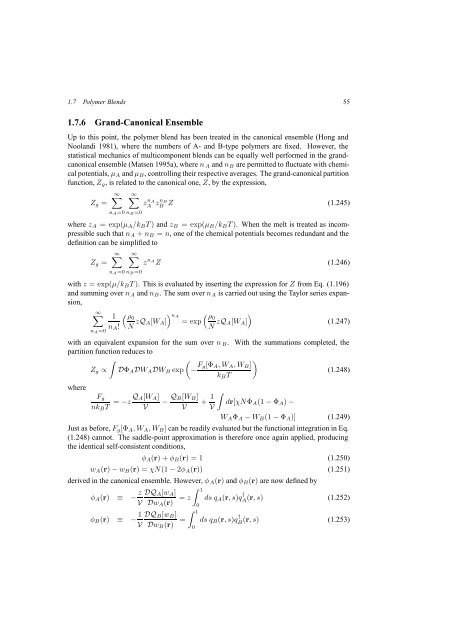Self-Consistent Field Theory and Its Applications by M. W. Matsen
Self-Consistent Field Theory and Its Applications by M. W. Matsen
Self-Consistent Field Theory and Its Applications by M. W. Matsen
You also want an ePaper? Increase the reach of your titles
YUMPU automatically turns print PDFs into web optimized ePapers that Google loves.
1.7 Polymer Blends 55<br />
1.7.6 Gr<strong>and</strong>-Canonical Ensemble<br />
Up to this point, the polymer blend has been treated in the canonical ensemble (Hong <strong>and</strong><br />
Nool<strong>and</strong>i 1981), where the numbers of A- <strong>and</strong> B-type polymers are fixed. However, the<br />
statistical mechanics of multicomponent blends can be equally well performed in the gr<strong>and</strong>canonical<br />
ensemble (<strong>Matsen</strong> 1995a), where n A <strong>and</strong> n B are permitted to fluctuate with chemical<br />
potentials, μ A <strong>and</strong> μ B , controlling their respective averages. The gr<strong>and</strong>-canonical partition<br />
function, Z g , is related to the canonical one, Z, <strong>by</strong> the expression,<br />
Z g =<br />
∞∑<br />
∞∑<br />
n A=0 n B=0<br />
z nA<br />
A<br />
znB B Z (1.245)<br />
where z A =exp(μ A /k B T ) <strong>and</strong> z B =exp(μ B /k B T ). When the melt is treated as incompressible<br />
such that n A + n B = n, one of the chemical potentials becomes redundant <strong>and</strong> the<br />
definition can be simplified to<br />
∞∑ ∞∑<br />
Z g = z nA Z (1.246)<br />
n A=0 n B=0<br />
with z =exp(μ/k B T ). This is evaluated <strong>by</strong> inserting the expression for Z from Eq. (1.196)<br />
<strong>and</strong> summing over n A <strong>and</strong> n B . The sum over n A is carried out using the Taylor series expansion,<br />
∞∑ 1<br />
( ρ0<br />
)<br />
n A ! N zQ nA<br />
( ρ0<br />
)<br />
A[W A ] =exp<br />
N zQ A[W A ]<br />
(1.247)<br />
n A=0<br />
with an equivalent expansion for the sum over n B . With the summations completed, the<br />
partition function reduces to<br />
∫<br />
(<br />
Z g ∝ DΦ A DW A DW B exp − F )<br />
g[Φ A ,W A ,W B ]<br />
(1.248)<br />
k B T<br />
where<br />
F g<br />
nk B T = −z Q A[W A ]<br />
− Q B[W B ]<br />
+ 1 ∫<br />
dr[χNΦ A (1 − Φ A ) −<br />
V V V<br />
W A Φ A − W B (1 − Φ A )] (1.249)<br />
Just as before, F g [Φ A ,W A ,W B ] can be readily evaluated but the functional integration in Eq.<br />
(1.248) cannot. The saddle-point approximation is therefore once again applied, producing<br />
the identical self-consistent conditions,<br />
φ A (r)+φ B (r) =1 (1.250)<br />
w A (r) − w B (r) =χN(1 − 2φ A (r)) (1.251)<br />
derived in the canonical ensemble. However, φ A (r) <strong>and</strong> φ B (r) are now defined <strong>by</strong><br />
φ A (r) ≡ − z V<br />
φ B (r) ≡ − 1 V<br />
DQ A [w A ]<br />
Dw A (r)<br />
DQ B [w B ]<br />
Dw B (r)<br />
= z<br />
=<br />
∫ 1<br />
0<br />
∫ 1<br />
0<br />
ds q A (r,s)q † A<br />
(r,s) (1.252)<br />
ds q B (r,s)q † B<br />
(r,s) (1.253)
















